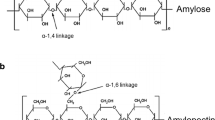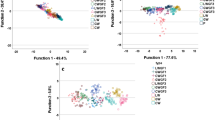Abstract
Resistant starch (RS) included in pasta can have auspicious health benefits and functional properties. The resistance of starch, however, can be greatly influenced by the applied food preparation process. The aim of the present study was to investigate the effects of two different resistant starches on the digestibility of pasta and to predict the impact of the conventional pasta processing (extrusion under standard conditions, 120 bars, 40°C; drying in an air-drying room at 35–40°C and cooking until the optimum cooking time) on the quality of different resistant starch included in products by using an in vitro enzymatic hydrolysis method. Results showed that the applied, conventional pasta extrusion step had only a small effect on the liberated glucose level and did not influence the RS content significantly. The cooking in contrast caused an increased digestibility and the lost of resistance of all pasta products. The digestibility was significantly lower (p < 0.05) in the case of raw and dried samples compared to the cooked pastas. It can be concluded that the resistant starches used in the samples are heat sensitive and their properties change radically during the pasta preparation, mainly during cooking.



Similar content being viewed by others
References
Annison, G., & Topping, D. L. (1994). Nutritional role of resistant starch: chemical structure vs physiological function. Annual Reviews of Nutrition, 14, 297–320.
Björck, I., Granfeldt, Y., Liljeberg, H., Tovar, J., & Asp, N.-G. (1994). Food properties affecting the digestion and absorption of carbohydrates. The American Journal of Clinical Nutrition, 59, S699–S705.
Björck, I., Liljeberg, H., & Ostman, E. (2000). Low glycaemic index foods. British Journal of Nutrition, 83, S149–S155.
Brand, J. C., Nicholson, P. L., Thorburn, A. W., & Truswell, A. S. (1985). Food processing and the glycemic index. The American Journal of Clinical Nutrition, 42, 1192–1196.
Brovedani, D., & Tyfield, S. (Eds.). (2000). Pasta: history, technologies and secrets of Italian tradition, Arti Grafiche Amilcare Pizzi S.p.A, Cinisello Balsamo, Milan, Italy
Codex Alimentarius Hungaricus (2007) Malomipari termékek 2–61 (Hun), 3rd ed.
Cunin, C., Handschin, S., Walther, P., & Escher, F. (1995). Structural changes of starch during cooking of durum wheat pasta. Lebensmittel Wissenschaft und Technologie, 28, 323–328.
Faraj, A., Vasanthan, T., & Hoover, R. (2004). The effect of extrusion cooking on resistant starch formation in waxy and regular barley flours. Food Research International, 37, 517–525.
Gelencsér, T., Gál, V., Hódsági, M., & Salgó, A. (2008). Evaluation of quality and digestibility characteristics of resistant starch-enriched pasta. Food and Bioprocess Technology: An International Journal, 1, 171–179.
Gelencsér, T., Juhász, R., Hódsági, M., Gergely, S., & Salgó, A. (2008). Comparative study of native and resistant starches. Acta Alimentaria, 37(2), 255–270.
Goñi, I., Garcia-Alonso, A., & Saura-Calixto, F. (1997). A starch hydrolisis procedure to estimate glycemic index. Nutrition Research, 17(3), 427–437.
Goñi, I., & Valentin-Gamazo, C. (2003). Chickpea flour ingredient slows glycemic response to pasta in healthy volunteers. Food Chemistry, 81, 511–515.
Güler, S., Köksel, H., & Ng, P. K. W. (2002). Effects of industrial pasta drying temperatures on starch properties and pasta quality. Food Research International, 35, 421–427.
Liljeberg, H. G. M., Åkerberg, A. K. E., & Björck, I. M. E. (1999). Effect of the glycemic index and content of indigestible carbohydrates of cereal-based breakfast meals on glucose tolerance at lunch in healthy subjects. American Journal of Clinical Nutrition, 69, 647–655.
Maache-Rezzoug, Z., & Allaf, K. (2005). Study of the effect of hydrothermal process conditions on pasta quality. Journal of Cereal Science, 41, 267–275.
Medcalf, D. G., & Gilles, K. A. (1965). Wheat starches. I. Comparison of physicochemical properties. Cereal Chemistry, 42, 558–568.
Megazyme (2004). Resistant starch assay procedure. AOAC Method 2002.02/ AACC Method (pp. 32–40) Ireland: Megazyme.
Meyer, K. A., Kushi, L. H., Jacobs, D. R., Slavin, J., Sellers, T. A., & Folsom, A. R. (2000). Carbohydrates, dietary fiber, and incident type 2 diabetes in older women. American Journal of Clinical Nutrition, 71, 921–930.
Muir, J. G., Birkett, A., Jones, G., & O’Dea, K. (1995). Food processing and maize variety affects amounts of starch escaping digestion in the small intestine. American Journal of Clinical Nutrition, 61, 82–89.
Nugent, A. P. (2005). Health properties of resistant starches. Nutrition Bulletin, 30, 27–54.
Tudorică, C. M., Kuri, V., & Brennan, C. S. (2002). Nutritional and physicochemical characteristics of dietary fiber-enriched pasta. Journal of Agricultural and Food Chemistry, 50, 347–356.
Tungland, B. C., & Meyer, D. (2002). Nondigestible oligo- and polysaccharides (dietary fiber): their physiology and role in human health and food. Comprehensive Reviews in Food Science and Food Safety, 1, 73–77.
Acknowledgment
This study was supported by DiOGenes, which is the acronym of the project ‘Diet, Obesity and Genes’ supported by the European Community (contract no. FOOD-CT-2005-513946). The members of the project are listed on the web-site of the project: http://www.diogenes-eu.org. The authors acknowledge the technical help of Cerbona Ltd. (Székesfehérvár, Hungary) in the processing of pasta products.
Author information
Authors and Affiliations
Corresponding author
Rights and permissions
About this article
Cite this article
Gelencsér, T., Gál, V. & Salgó, A. Effects of Applied Process on the In Vitro Digestibility and Resistant Starch Content of Pasta Products. Food Bioprocess Technol 3, 491–497 (2010). https://doi.org/10.1007/s11947-008-0105-7
Received:
Accepted:
Published:
Issue Date:
DOI: https://doi.org/10.1007/s11947-008-0105-7




